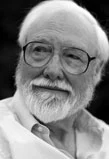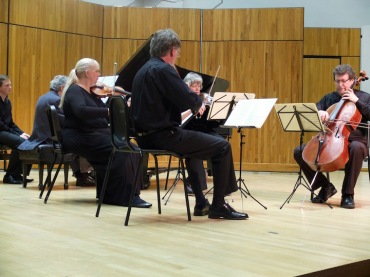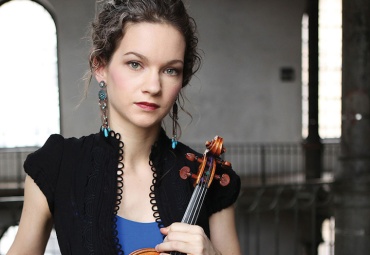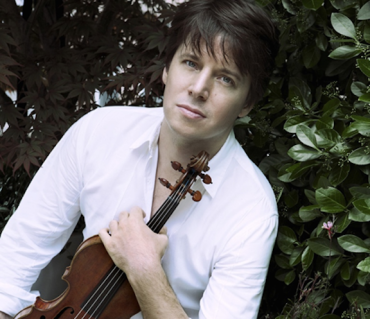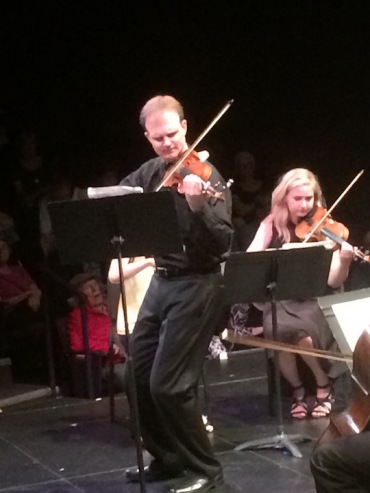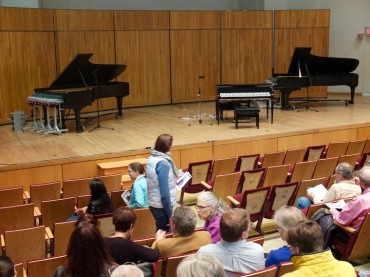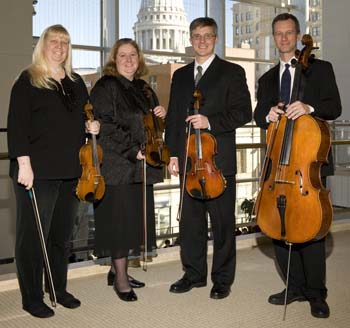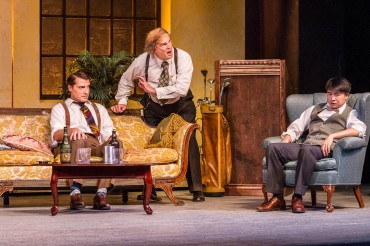The Well-Tempered Ear
Classical music: Here are memorable local concerts in 2016 from critic John W. Barker and The Ear. What ones would you add?
1 Comment
ALERT: The FREE Friday Noon Musicales at the First Unitarian Society of Madison, 900 University Bay Drive, resume this week after a break for Christmas, New Year’s and other holidays. This Friday, from 12:15 to 1 p.m., pianist Olivia Musat will perform music by Olivier Messiaen, Isaac Albeniz and Paul Constantinesco.
By Jacob Stockinger
It seems a tradition throughout the media to offer a roundup of the Year’s Best with a local slant.
The Ear already offered a national and international roundup. Here is a link to that, especially to the surprisingly rich roundup that he unexpectedly found on Wikipedia:
For a more local perspective, The Ear trusts and generally agrees with critic John W. Barker (below), who writes frequently for this blog and more often for Isthmus.
Here is a link to Barker’s list of memorable concerts in the Madison area, Because Isthmus mixes classical with other genres like pop, folk and jazz, you have to scroll down to “Classical cornucopia”:
http://isthmus.com/music/year-in-music-2016/
Although I agree with all the concerts that Barker mentions, he left out some that The Ear really loved. One was the absolutely riveting and moving performance in November by the Madison Symphony Orchestra under John DeMain of the momentous Fifth Symphony by Dmitri Shostakovich.
For example just about everything that the Pro Arte Quartet does at the University of Wisconsin-Madison School of Music is first-rate and memorable, whether they play in Mills Hall or on “Sunday Afternoon Live From the Chazen Museum of Art.”
But this past fall, a free noontime concert by the Pro Arte with legendary pianist Leon Fleisher especially stood out. Together (below), they performed the Piano Quintet in F Minor by Johannes Brahms – an unquestionable masterpiece in an unforgettable performance.
The Ear would also add two events, both violin recitals, at the Wisconsin Union Theater.
Last spring Hilary Hahn (below top, in a photo by Peter Miller) turned in a stunningly superb recital. Then this fall, superstar Joshua Bell (below bottom) did the same. Both artists displayed terrific musicality combined with terrific virtuosity in generous and first-rate, ambitious programs.
He would add several summer concerts by the Bach Dancing and Dynamite Society, especially the sizzling dueling violin concert (below) where the BDDS interspersed “The Four Seasons” buy Antonio Vivaldi with “The Four Seasons in Buenos Aires” by Astor Piazzolla.
The Ear would also add an experimental concert at which UW-Madison pianist Christopher Taylor (below) unveiled his reworked two-keyboard “Hyperpiano.” While the concert, which featured the “Goldberg” Variations by Johann Sebastian Bach, wasn’t successful musically, it certainly was intriguing, unusual and highly memorable, even with imperfect digital technology.
And The Ear also recalls a fine concert by the Rhapsodie Quartet (below) of the Madison Symphony Orchestra at the Overture Center.
And let’s not forget the University Opera’s production of “Falstaff” by Giuseppe Verdi that was impressively and successfully updated to Hollywood by director David Ronis.
The Ear is sure there are more memorable concerts that escape him right now. Madison just features so much wonderful music-making in the course of a year.
Moreover, The Ear is also sure you have your favorites – whether they are individual plays; small chamber music groups such as duos, string quartets and piano trios; larger ensembles like the Madison Symphony Orchestra and the Wisconsin Union Theater; or entire events like the UW Brass Festival.
I am sure that fans of the innovative percussion group Clocks in Motion and the acclaimed Madison Choral Project have a concert or two to nominate.
So please use the COMMENT section to tell us what were your most memorable classical concerts in Madison during 2016.
The Ear wants to hear.
Tags: "Goldberg" Variations, Albeniz, Arts, Ástor Piazzolla, Bach, Bach Dancing and Dynamite Society, Baroque, BDDS, brass, Brass Festival, Cello, Chamber music, Chazen Museum of Art, choral music, Christmas, Christopher Taylor, Classical music, Clocks in Motion, concerto, David Ronis, digital, duets, duo, Early music, Falstaff, First Unitarian Society of Madison, folk, Four Seasons, Four Seasons of Buenos Aires, Franz Schubert, Hilary Hahn, Holiday, Hollywood, Hyperpiano, Isthmus, Jacob Stockinger, Jazz, Johann Sebastian Bach, Johannes Brahms, John DeMain, John Wilbye, Joshua Bell, Ludwig van Beethoven, Madison, Madison Choral Project, Madison Opera, Madison Symphony Orchestra, Messiaen, Mozart, Music, New Year, New Year's, opera, Orchestra, Overture Center, Paul Constantinesco, percussion, Piano, pop, Pro Arte Quartet, Quartet, quintet, Shakespeare, Shostakovich, Sonata, String quartet, Sunday Afternoon Live From the Chazen, symphony, technology, trio, United States, University of Wisconsin-Madison School of Music, University of Wisconsin–Madison, University Opera, Verdi, Viola, Violin, Vivaldi, vocal music, Wisconsin, Wisconsin Chamber Orchestra, Wisconsin Union Theater, Wolfgang Amadeus Mozart
Classical music: What’s the point of the new “Hyperpiano” if it just mars the music, frustrates the performer and alienates the audience?
16 Comments
By Jacob Stockinger
Like everyone in the almost sold-out house at Mills Hall last Friday night, The Ear went to hear the wonderfully gifted UW-Madison piano virtuoso Christopher Taylor unveil his new hi-tech invention: the so-called “Hyperpiano.”
Taylor (below) patiently explained in detail how the hybrid electronic-acoustic piano was conceived and developed, and then how it worked.
Here is a link to two stories with detailed background:
https://uwmadisonschoolofmusic.wordpress.com/2016/09/13/christopher-taylor-to-debut-new-piano/
But at the risk of hurting the feelings of the brilliant and personable Taylor, The Ear has to confess: He left the event – more an experiment or demonstration than a concert – disappointed. He just doesn’t see the point. It seems a case where the idea will inevitably prove superior to the reality.
This new piano, conceived and executed by Taylor with lots of help, features a digital-like console (below) with two keyboards. The console then links up electronically to two regular acoustic concert grand pianos by means of lots of wires. Wires pass along electronic digital impulses to mechanical fingers that hit actual piano keys and makes traditional pianos play.
If the Hyperpiano sounds like some kind of Rube Goldberg contraption, well, that’s because it IS. Ingenious, yes; practical, hardly.
The piece Taylor used to demonstrate his new piano was the momentous and magnificent “Goldberg” Variations by Johann Sebastian Bach, a promising and appealing challenge for the new piano. The Ear has heard Taylor play this music before, and it was a memorable experience.
Not this time.
A great instrument is supposed to make playing easier, to bring both the performer and the audience closer to the music. But this new piano interfered with both and did just the opposite. It put you on edge, just waiting for the next thing to go wrong and get fixed and then go wrong again. It made no sense, and little beauty.
Clearly the Hyperpiano – more accurately dubbed Frankenpiano by Taylor’s students — is a technological curiosity that is still a work-in-progress, with lots of snags and flaws that became apparent during 2-1/2 hours.
But even had it worked perfectly, The Ear asks: What is the point?
Certainly it makes for an interesting electrical engineering problem to solve, one that eats up lots of time, thought, energy and money. But why have three $100,000 concert grand pianos and a custom-built piano console all on the stage when a single traditional piano would do the job just fine?
Single-keyboard pianos have brought us many memorable performances of the Goldbergs – including those by Rosalyn Tureck, Glenn Gould, Andras Schiff, Jeremy Denk, Murray Perahia and Angela Hewitt among others, to say nothing of Taylor himself.
And on stage was an old one-of-a-kind, two-keyboard Steinway that Taylor has used before to fine effect, rather like the two-manual harpsichord that Bach originally wrote the music for and that facilitates the difficult cross-hand passages.
Despite distractions, Taylor played the Bach with total commitment and enthusiasm as well as with his back to the audience, as piano recitals used to be played before the young Franz Liszt turned the piano sideways to show off his heart-throb profile.
Yet the misfiring of electrodes plus an unending loud chirp or tweet and the uneven pistons or clunky mini-jackhammers (below) that hit the keyboards as artificial “fingers” just meant a lot of dropped notes and, for the most part, a very choppy reading of Bach’s great music that stymied both the performer and the listeners.
Compounding the performance was that Taylor took all the repeats, which often just doubled the frustration. How The Ear wishes Taylor had played just the first half on the Hyperpiano and then, for comparison, switched to a regular piano or to the two-keyboard Steinway.
True, at the end the audience gave Taylor well earned applause and a prolonged standing ovation. But The Ear suspects it was more for his perseverance, patience, good humor and stupendous effort than for the music itself or the new piano. He bets only a very few listeners would pay to go back to hear another recital on the Hyperpiano.
Will Taylor continue to work on improving the terrifically complex Hyperpiano? Yes, one suspects that he will and one wishes him success. But wouldn’t all that time and effort be better spent learning new music and performing it?
The Ear says: Enough hype about the Hyperpiano!
It’s time for a great musician to get back to the music.
Did you go hear the Hyperpiano?
What do you think?
The Ear wants to hear.
Tags: "Goldberg" Variations, András Schiff, Angela Hewitt, Arts, Bach, Baroque, Christopher Taylor, Classical music, digital, electronic, experiment, Glenn Gould, Hyperpiano, Jacob Stockinger, Johann Sebastian Bach, Liszt, Madison, Murray Perahia, Music, Piano, Steinway, United States, University of Wisconsin-Madison School of Music, University of Wisconsin–Madison, Wisconsin
- May 2024
- April 2024
- March 2024
- February 2024
- January 2024
- December 2023
- November 2023
- October 2023
- September 2023
- August 2023
- July 2023
- June 2023
- May 2023
- April 2023
- March 2023
- February 2023
- January 2023
- December 2022
- October 2022
- September 2022
- June 2022
- May 2022
- April 2022
- March 2022
- July 2021
- June 2021
- May 2021
- April 2021
- March 2021
- February 2021
- January 2021
- December 2020
- November 2020
- October 2020
- September 2020
- August 2020
- July 2020
- June 2020
- May 2020
- April 2020
- March 2020
- February 2020
- January 2020
- December 2019
- November 2019
- October 2019
- September 2019
- August 2019
- July 2019
- June 2019
- May 2019
- April 2019
- March 2019
- February 2019
- January 2019
- December 2018
- November 2018
- October 2018
- September 2018
- August 2018
- July 2018
- June 2018
- May 2018
- April 2018
- March 2018
- February 2018
- January 2018
- December 2017
- November 2017
- October 2017
- September 2017
- August 2017
- July 2017
- June 2017
- May 2017
- April 2017
- March 2017
- February 2017
- January 2017
- December 2016
- November 2016
- October 2016
- September 2016
- August 2016
- July 2016
- June 2016
- May 2016
- April 2016
- March 2016
- February 2016
- January 2016
- December 2015
- November 2015
- October 2015
- September 2015
- August 2015
- July 2015
- June 2015
- May 2015
- April 2015
- March 2015
- February 2015
- January 2015
- December 2014
- November 2014
- October 2014
- September 2014
- August 2014
- July 2014
- June 2014
- May 2014
- April 2014
- March 2014
- February 2014
- January 2014
- December 2013
- November 2013
- October 2013
- September 2013
- August 2013
- July 2013
- June 2013
- May 2013
- April 2013
- March 2013
- February 2013
- January 2013
- December 2012
- November 2012
- October 2012
- September 2012
- August 2012
- July 2012
- June 2012
- May 2012
- April 2012
- March 2012
- February 2012
- January 2012
- December 2011
- November 2011
- October 2011
- September 2011
- August 2011
- July 2011
- June 2011
- May 2011
- April 2011
- March 2011
- February 2011
- January 2011
- December 2010
- November 2010
- October 2010
- September 2010
- August 2010
- July 2010
- June 2010
- May 2010
- April 2010
- March 2010
- February 2010
- January 2010
- December 2009
- November 2009
- October 2009
- September 2009
- August 2009
Archives
- 2,491,618 hits
Blog Stats
Recent Comments
| Brian Jefferies on Classical music: A major reass… | |
| welltemperedear on What made Beethoven sick and… | |
| rlhess5d5b7e5dff on What made Beethoven sick and… | |
| welltemperedear on Beethoven’s Ninth turns 200… | |
| Robert Graebner on Beethoven’s Ninth turns 200… |
Tags
#BlogPost #BlogPosting #ChamberMusic #FacebookPost #FacebookPosting #MeadWitterSchoolofMusic #TheEar #UniversityofWisconsin-Madison #YouTubevideo Arts audience Bach Baroque Beethoven blog Cello Chamber music choral music Classical music Compact Disc composer Concert concerto conductor Early music Facebook forward Franz Schubert George Frideric Handel Jacob Stockinger Johannes Brahms Johann Sebastian Bach John DeMain like link Ludwig van Beethoven Madison Madison Opera Madison Symphony Orchestra Mead Witter School of Music Mozart Music New Music New York City NPR opera Orchestra Overture Center performer Pianist Piano post posting program share singer Sonata song soprano String quartet Student symphony tag The Ear United States University of Wisconsin-Madison School of Music University of Wisconsin–Madison Viola Violin vocal music Wisconsin Wisconsin Chamber Orchestra wisconsin public radio Wolfgang Amadeus Mozart YouTube